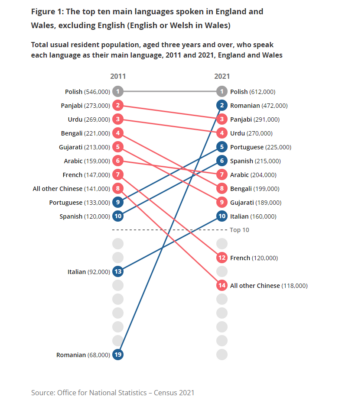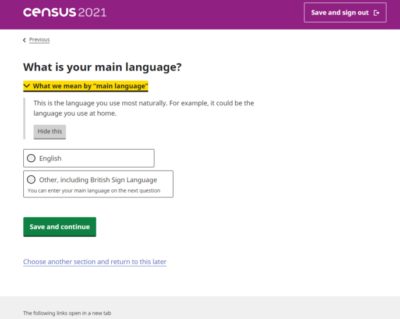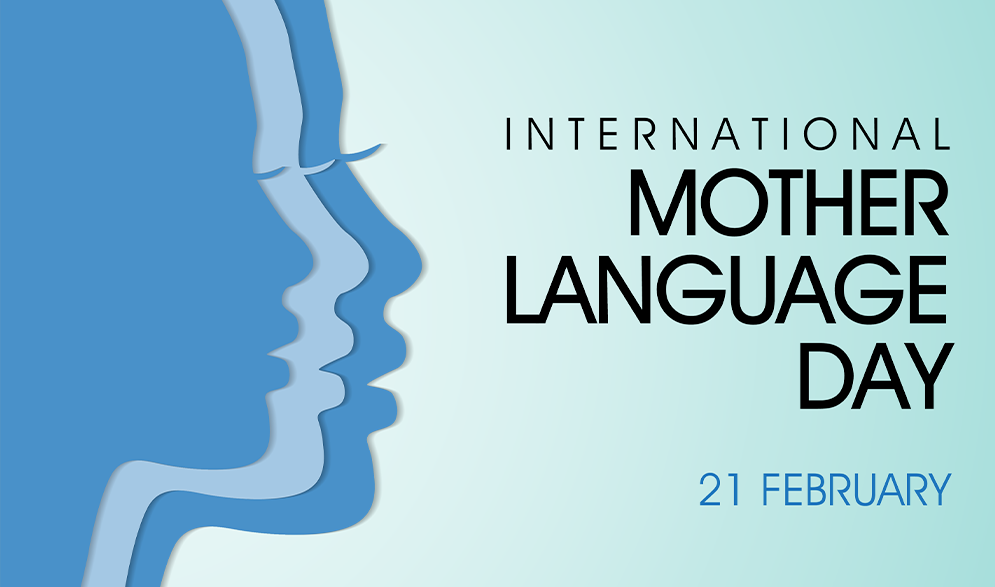Blog editor, Carmen Silvestri, reflects on International Mother Language Day (IML) in light of the language results of the 2021 UK Census
![]() In March 2021, during the third COVID lockdown, the office for national statistics (ONS) invited the citizens resident in the UK to complete the census. For the first time, a national census was in digital form and reached the highest response rate ever recorded. The first results for the section regarding ethnic group, national identity, language and religion were released at the end of 2022, and for IML day we share here some reflections and thoughts about it.
In March 2021, during the third COVID lockdown, the office for national statistics (ONS) invited the citizens resident in the UK to complete the census. For the first time, a national census was in digital form and reached the highest response rate ever recorded. The first results for the section regarding ethnic group, national identity, language and religion were released at the end of 2022, and for IML day we share here some reflections and thoughts about it.
These preliminary results portray an increasingly diverse UK society, where ethnic identities and national affiliations, and consequently cultural-linguistic systems, are increasingly varied. But what information was collected and how? Could society be even more varied than the one portrayed by the statistics? And what do these results mean for educators?
Languages in England and Wales
Considering the overall population growth in England and Wales since the last census, the number of people who declared speaking English as their main language increased, going from 49.8 million in 2011 to 52.6 million in 2021. However, we find of interest the decrease in proportion from 92.3% of people reporting English as their main language in 2011 to 91.1% in 2021. This change is proportionally related to an increase in people reporting a main language other than English.

Whilst Polish remains the most spoken language after English, the census registered a decrease in number and percentage for languages that originate in Asia/South Asia like Panjabi, Urdu, Bengali, Gujarati, and an increase for Portuguese, Spanish and Italian, potentially reflecting the effects of the 2010 Eurozone crisis.
The most remarkable change that we can notice in the chart above, however, is the journey of the Romanian language from holding the 19th position among the main languages other than English to representing the third most spoken language in the country after English and Polish.
Source: Office for National Statistics (2022) Language, England and Wales: Census 2021
The main language
UK residents were invited to answer the following question:
“What is your main language? This is the language you use more naturally. For example, it could be the language you use at home”

What is your main language is the only question about language in the current census. We wonder what ‘main’ means and how the picture would change if each person would be given the chance to report about their full linguistic repertoire.
During the second half of the 19th century, many countries followed Belgium’s lead and included questions about languages in their census (O’Gliasain, 1996). However, questions would be differently posed in each country and even within the same national censuses, questions changed across time. For instance, the census in Slovenia started by collecting data about ‘the language of thought’ in 1923 but then conformed to more commonly used criteria in other countries and started asking for ‘the language of the household’ (Makoni and Pennycook, 2007, p.12). But in an increasingly diverse society, asking for the language of the household can be limiting. In fact, the results of the 2021 UK Census bring to light the reality of multilingual families and households. Out of the 17 million households with more than one person, 1.5 million are reported to have different main languages.
An example of this could be a family of four where one of the parents comes from a different country. Let’s imagine this scenario. Francesca moves to England from Italy. She completes the census and inserts her ‘mother language’, Italian, as her main language. Her partner adds English as their main language but they also speak Italian and work for a French firm where they mainly speak French. They have two children, Sarah and Federico. They were born and raised in the UK and since English is the language of schooling and the language of their peers, they register English as their main language. Yet, the children also speak Italian with their family. It is indeed their mother language. In this scenario, Francesca’s family would represent one of the 1.5 million households with different main languages. But it is clear that asking for the main language would not provide an accurate picture of their multilingual life.
Let’s stay with Francesca and her family. She may decide to opt for English as her main language because this is the language she uses the most and with which she feels more comfortable after many years of living in the UK. Her family may now be one of the 15.8 households with the same main language. In this case, their linguistic asset would go completely unacknowledged.
Language proficiency in English
Of those 5.1 million people that reported speaking English as a second/additional language, 79.7% declared to speak English well or very well and about one-fifth seem to have no or limited proficiency in English. Compared to the previous census, we do not find a percentual difference, and numbers increased proportionally. The need for continuous support in the areas of English as an Additional Language (EAL) and English for Speakers of Other Languages (ESOL) is undoubted.
Implications for language education
This week, we celebrate the 24th International Mother Language Day. Promoted by UNESCO in 1999 and supported by the United Nation, this initiative reminds us of the importance of preserving the linguistic resources of everyone and celebrating multilingualism for the development of inclusive societies (UN, 2023). The theme for this year is “Multilingual education – a necessity to transform education“. At NALDIC we are aware of the challenges that multilingual students face in highly monolingual school systems and we fully embrace the call for a more inclusive, egalitarian and rich form of education that takes into account, and effectively employs, the linguistic resources already present in our classrooms. Extensive research in the field of language and education, including the work on translanguaging, confirms the benefits of adopting a multilingual approach to education. In light of the Census results, educators may develop their practice with further knowledge of the languages spoken not only in their schools but in their boroughs and cities, and support their pupils in enhancing awareness of multilingualism in their communities at large.
References
Makoni, S., & Pennycook, A. (2007). Disinventing and Reconstituting Languages. In Disinventing and Reconstituting Languages. Clevedon: Multilingual Matters.
Ó Gliasáin, M. (1996) The language question in the census of population/Ceist na teanga sa daonáireamh. Research report 21. Linguistics Institute of Ireland/Institiúid Teangeolaíochta Éireann.
United Nations (2023) International Mother Language Day 21 February. www.un.org. https://www.un.org/en/observances/mother-language-day


